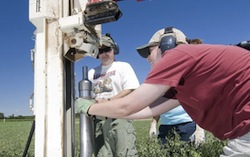 According to an article in Nature, researchers with Michigan State University (MSU) show that marginal lands can serve as prime real estate for meeting alternative energy production goals. By growing mixed-species cellulosic biomass, marginal lands could annually produce up to 5.5 billion gallons of ethanol in the Midwest alone.
According to an article in Nature, researchers with Michigan State University (MSU) show that marginal lands can serve as prime real estate for meeting alternative energy production goals. By growing mixed-species cellulosic biomass, marginal lands could annually produce up to 5.5 billion gallons of ethanol in the Midwest alone.
“Understanding the environmental impact of widespread biofuel production is a major unanswered question in the U.S. and worldwide,” said Ilya Gelfand, lead author of the paper. “We estimate that using marginal lands for growing cellulosic biomass crops could provide up to 215 gallons of ethanol per acre with substantial greenhouse gas mitigation.” According to Gelfand, this is the first study to provide an estimate for greenhouse gas benefits, and an assessment of the total potential of these lands to produce significant amounts of biomass.
Researchers from MSU, the Pacific Northwest National Laboratory and the University of Maryland used 20 years of data, focused on 10 Midwestern states, from the National Science Foundation (NSF) Kellogg Biological Station (KBS) Long-Term Ecological Research (LTER) site. Kellogg Biological Station is one of 26 such NSF LTER sites in ecosystems around the world from grasslands to deserts, coral reefs to tundra.
“The study underscores the critical role that long-term basic research plays in determining the optimum balance between economic prosperity and environmental sustainability,” said Saran Twombly, program director in NSF’s Division of Environmental Biology. “Long-term basic experiments suggest that wise management of marginal lands, rather than wholesale conversion of valuable agricultural lands, could contribute significantly to a sustainable future.”
 The scientists characterized the comparative productivity and greenhouse gas impacts of different crops, including corn, poplar, alfalfa and old-field vegetation. Next they used a supercomputer to identify and model biomass production that could grow enough feedstock to support a local biorefinery with a capacity of at least 24 million gallons per year.
The scientists characterized the comparative productivity and greenhouse gas impacts of different crops, including corn, poplar, alfalfa and old-field vegetation. Next they used a supercomputer to identify and model biomass production that could grow enough feedstock to support a local biorefinery with a capacity of at least 24 million gallons per year.
According to Phil Robertson, co-author of the paper and director of the KBS LTER site, the final tally of 5.5 billion gallons of ethanol represents about 25 percent of Congress’ 2022 cellulosic biofuels target. “The value of marginal lands for energy production has been long-speculated and often discounted. This research shows that these lands could make a major contribution to transportation energy needs, while providing substantial climate and–if managed properly–conservation benefits.”
Robertson added that this is also the first study to demonstrate that grasses and other non-woody plants that grow naturally on unmanaged lands are sufficiently productive to make ethanol production worthwhile.

